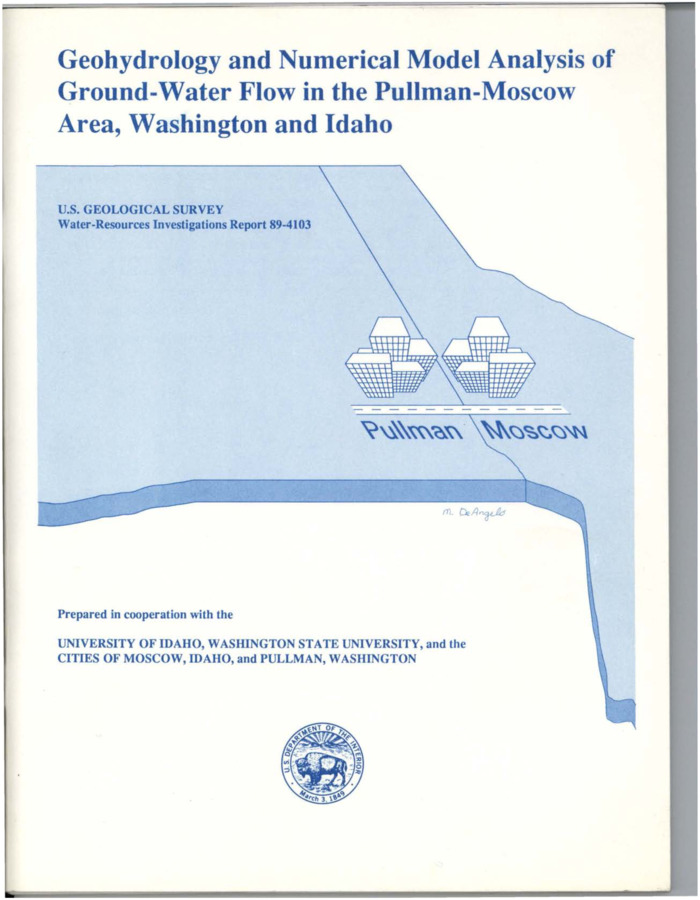PDF
Geohydrology and numerical model analysis of ground-water flow in the Pullman-Moscow area, Washington and Idaho. U.S. Geological Survey Water-resources investigations report 89-4103 Item Info
- Title:
- Geohydrology and numerical model analysis of ground-water flow in the Pullman-Moscow area, Washington and Idaho. U.S. Geological Survey Water-resources investigations report 89-4103
- Authors:
- Lum, W. E. II; Smoot, J. L.; Ralston, D. R.
- Date:
- 1990
- Description:
- The Pullman-Moscow area of southeastern Washington and northern Idaho depends on groundwater as the principal source of water, but increasing pumpage rates and declining groundwater levels indicate a need for groundwater management. Using data from a study done by the U.S. Geological Survey in the 1970's and up-to-date data collected for this study, a three-dimensional numerical computer model of the groundwater-flow system was constructed to provide an understanding of the geohydrology of the study area. The groundwater-flow model incorporates three layers -- an overlying surficial loess layer, a Wanapum Basalt layer, and a Grande Ronde Basalt layer. A groundwater-system recharge rate was estimated using a methodology developed by the U.S. Geological Survey. groundwater discharge was modeled as groundwater pumping, flow to rivers and streams, and flow out of seepage faces, where a layer is incised by a river valley. Three cross-sectional flow models, distributed across the domain of the three-dimensional model along estimated flow lines in the Grande Ronde Basalt, were used to obtain hydraulic coefficient input for the three-dimensional model. The three-dimensional model was calibrated using the time-averaged method for the period 1974-85, and was evaluated by simulating historical pumpage rate changes (1890-1985) and comparing simulated with observed water-level changes. Model results suggest that groundwater levels would stop declining if groundwater pumpage were to stabilize at a constant level. However, groundwater levels will continue to decline in the foreseeable future as long as groundwater pumpage continues to increase. Further study of the recharge, movement, and discharge of groundwater in the area is needed to increase the accuracy of any groundwater-flow model to predict the response of the flow system to future pumping stresses.
- Subjects:
- groundwater groundwater development confined aquifers unconfined aquifers water supply computer models
- Location:
- Pullman, Washington; Moscow, Idaho; Northern Idaho
- Idaho County:
- Latah County
- Latitude:
- 46.74
- Longitude:
- -117.17
- Collection:
- Palouse Basin
- Source:
- Idaho Water Resources Research Institute, University of Idaho
- Identifier:
- IWRRI Number 199004
- Publisher:
- Idaho Water Resources Research Institute, University of Idaho
- Contributing Institution:
- University of Idaho
- Type:
- Text
- Format:
- application/pdf
- Cataloger:
- KIT
- Date Digitized:
- 2017-09-12
- Language:
- eng
Source
- Preferred Citation:
- "Geohydrology and numerical model analysis of ground-water flow in the Pullman-Moscow area, Washington and Idaho. U.S. Geological Survey Water-resources investigations report 89-4103", Idaho Waters Digital Library, University of Idaho Library Digital Collections, https://www.lib.uidaho.edu/digital/iwdl/items/iwdl-199004.html
Rights
- Rights:
- In copyright, educational use permitted. Educational use includes non-commercial reproduction of text and images in materials for teaching and research purposes. For other contexts beyond fair use, including digital reproduction, please contact the University of Idaho Library Special Collections and Archives Department at libspec@uidaho.edu. The University of Idaho Library is not liable for any violations of the law by users.
- Standardized Rights:
- http://rightsstatements.org/vocab/InC-EDU/1.0/

